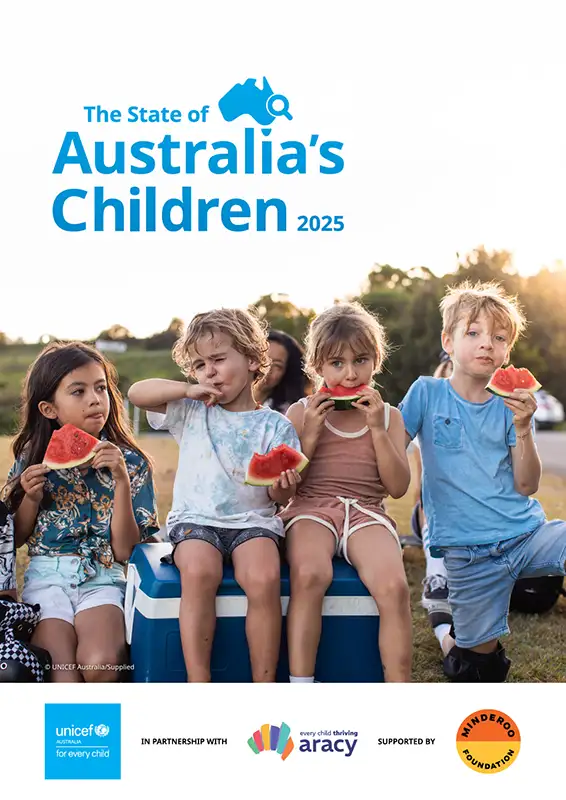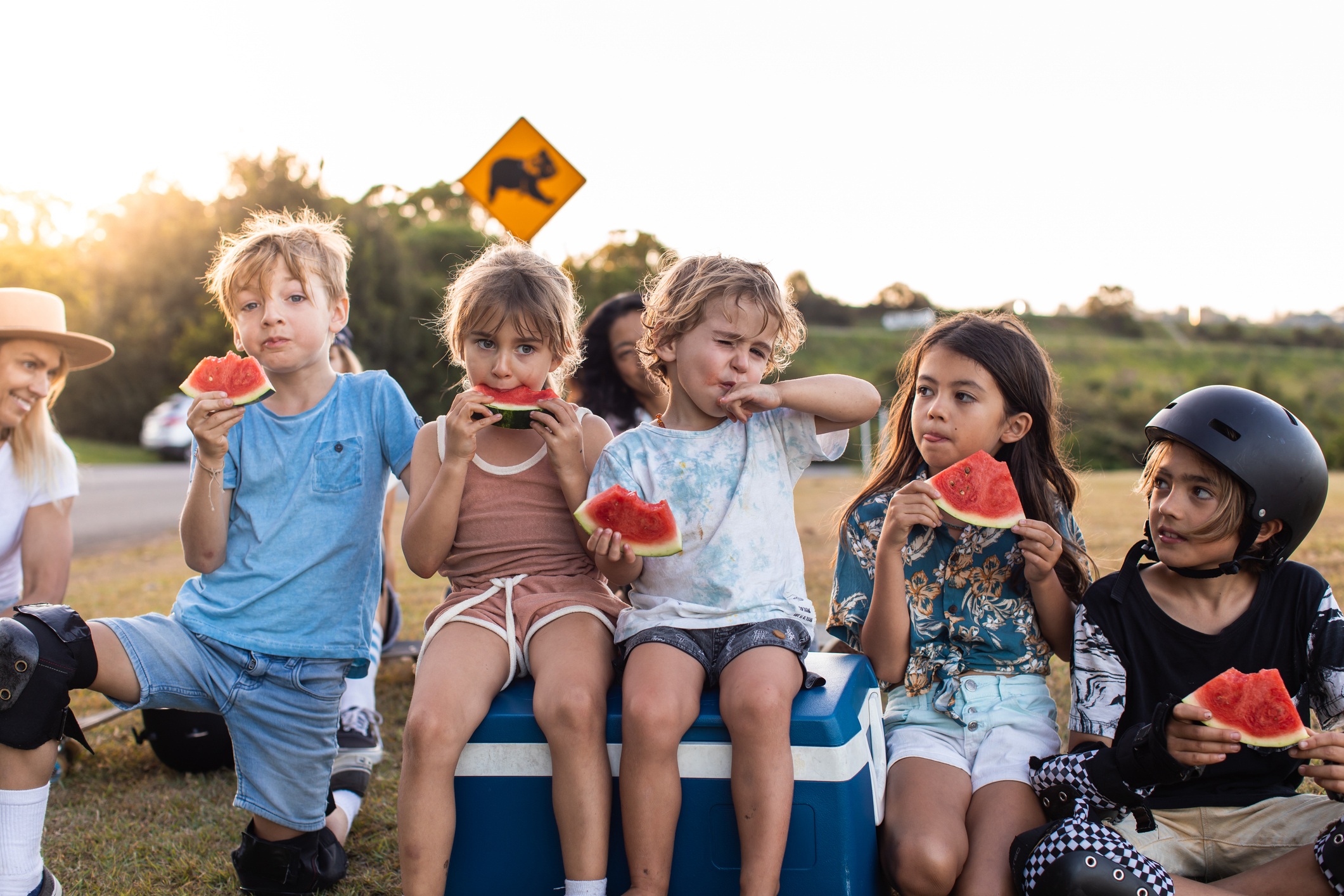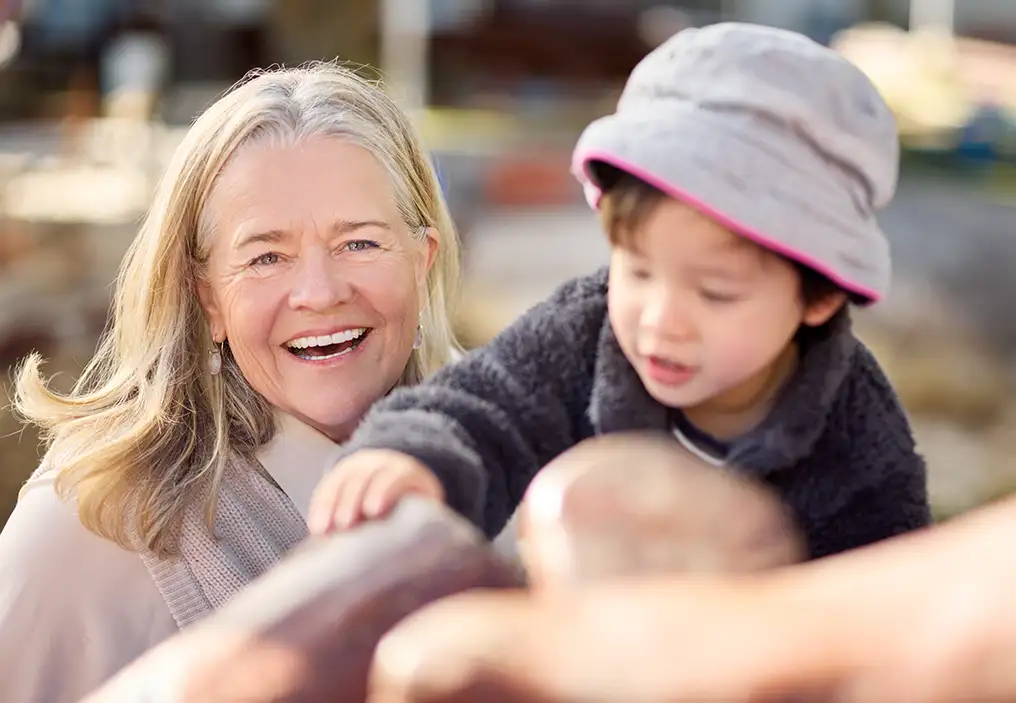
For the first time, Australia has a national snapshot of how children and young people are really doing.
Developed by UNICEF Australia and the Australian Research Alliance for Children and Youth, The State of Australia’s Children report brings together more than 100 datasets and the voices of over 2,000 children to show where kids are thriving, where they are falling behind, and what needs to change in the early years to set them up for life.
Half of all children start school developmentally on track. Many families face rising costs, limited access to early learning and growing housing stress. These pressures affect nutrition, sleep, learning and emotional development long before adolescence.
In this explainer, we break down the data, share what children say makes them feel safe and happy, and outline the steps Australia can take to give every child the strongest start.

The State of Australia’s Children
Developed by UNICEF Australia in partnership with Australian Research Alliance for Children and Youth (ARACY) and supported by Minderoo Foundation, the report takes a comprehensive look at the wellbeing of children and youth across the nation.
Enriching the latest publicly available data with the perspectives of Australia's children and young people, The State of Australia’s Children report is a holistic view of how the country’s youth are faring.
References
All references are to The State of Australia’s Children.
[1] Script: “The early years from conception to five are when our children’s brains develop faster than at any other time in life.”
Report Quote (p.5): “The science is unequivocal: the first five years shape a lifetime, yet too many children are starting school without the foundations they need to thrive.”
[2] Script: “But right now in Australia, not every child is getting what they need to thrive.”
Report Quote (p.7): “Despite Australia’s favourable conditions, the latest data shows that not every child currently has the same opportunity to thrive.”
[3] Script: “When children don’t get the support they need in the early years, it can make it harder for them later in life.”
Report Quote (p.5): “These outcomes are not sudden – they are the cumulative effect of missed opportunities in the early years. They echo into adolescence and young adulthood.”
[4] Script: “But by creating strong environments and experiences early on, we can set every child on a path toward lifelong health, learning and wellbeing.”
Report Quote (p.6): “Early experiences shape children’s brain development and set strong foundations for lifelong health and wellbeing.”
[5] Script: “The State of Australia’s Children Report is a snapshot of how our children are faring across the country.”
Report Quote (p.4): “The State of Australia’s Children offers a comprehensive evidence-based picture of how children and young people are faring across our nation.”
[6] Script: “The report uses The Nest Wellbeing Framework, Australia’s first evidence-based national framework for child and youth wellbeing.”
Report Quote (p.32): “The data in this report is organised by The Nest. The Nest is Australia’s national wellbeing framework for children and young people aged 0–24 years.”
[7] Script: “It identifies six interconnected domains essential for children and young people to thrive:”
Report Quote (p.32): “The Nest captures the things children need to survive and thrive, through six interconnected domains: Valued, Loved and Safe; Material Basics; Healthy; Learning; Participating; Positive Sense of Identity and Culture.”
[8] Script: “Many Australian children and young people are doing well.”
Report Quote (p.6): “This report shows that many children and young people are getting the support they need. It highlights positive progress and foundations on which to build.”
[9] Script: “But the data also reveals a concerning picture of growing inequities and emerging risks across many aspects of child and youth wellbeing.”
Report Quote (p.4): “While many children are thriving, too many are being left behind—held back by entrenched disadvantage, systemic racism, poverty and the enduring impacts of intergenerational trauma.”
[10] Script: “By the time Australian children start school, just over 50% are developmentally on track.”
Report Quote (p.26): “52.9% of all children aged 5 years are developmentally on track in all five domains according to the AEDC.”
[11] Script: “For Aboriginal and Torres Strait Islander children, that figure drops to just over 30%.”
Report Quote (p.26): “33.9% of Aboriginal and Torres Strait Islander children are developmentally on track.”
[12] Script: “Only 4.3% of children aged 2–17 meet minimum fruit and vegetable intake guidelines”
Report Quote (p.12): “Children’s dietary intake is a cause of concern with only 4.3% of children meeting the recommended intake of fruit and vegetables.”
[13] Script: “64% of young people report positive peer relationships”
Report Quote (p.45): “64% seeking support from their peers.”
[14] Script: “and 59% report positive relationships with parents”
Report Quote (p.45): “59 percent turning to their parents.”
[15] Script: “What happens in the early years can shape a child’s future.”
Report Quote (p.6): “Early experiences shape children’s brain development and set strong foundations for lifelong health and wellbeing.”
[16] Script: “The six domains of the Nest Wellbeing Framework are interconnected—each equally important to the development of Australia’s children.”
Report Quote (p.32): “These domains correlate with The Nest framework and are informed by the United Nations Convention on the Rights of the Child (UNCRC).”
[17] Script: “Almost nine in ten children in Australia attend preschool in the year before regular school—one of the highest rates in the world.”
Report Quote (p.94): “Early childhood education enrolment is high, with 89.2% of children enrolled in a preschool program in the year before school.”
[18] Script: “But access is not equal, especially in remote and disadvantaged communities.”
Report Quote (p.103): “24% of regions in Australia are childcare deserts… more often found in rural and remote areas.”
[19] Script: “When children miss out on preschool, they often start their learning journey already behind.”
Report Quote (p.99): “Children starting school behind with developmental vulnerability require additional support… We can also support more children to stay on track through investment in the early years.”
[20] Script: “Families reading aloud to children builds language, curiosity, and emotional connection—one of the most effective forms of early learning.”
Report Quote (p.95): “There is a direct correlation between being read to regularly by parents and cognitive and language outcomes.”
[21] Script: “But the number of families who read together daily has dropped from around 70% to 67.8% in just a few years.”
Report Quote (p.94): “The percentage of parents… identified as reading to their children regularly has fallen… and is at its lowest level at 67.8%.”
[22] Script: “Many areas in Australia are childcare ‘deserts’—areas without enough early learning places for local families.”
Report Quote (p.103): “24% of regions in Australia are childcare deserts… more often found in rural and remote areas.”
[23] Script: “When families have access to quality early learning opportunities, children get the support they need to thrive, and parents can fully participate in work and community life.”
Report Quote (p.67): “Greater interventions and targeted supports are needed to ensure all children… have the material basics required to grow and thrive.”
[24] Script: “We also know that one in six Australian children lives in poverty.”
Report Quote (p.70): “One in six children were living in poverty in 2020… with an estimated 102,000 more… by 2022 due to rising living costs and housing stress.”
[25] Script: “Poverty in the early years affects everything: • Nutrition • Sleep • Emotional regulation • And Brain development”
Report Quote (p.23): “Cost-of-living pressures… contribute to worsening outcomes in health, education, housing, and nutrition.”
[26] Script: “Rising cost-of-living pressures and housing stress place increasing strain on families, with serious repercussions for children’s wellbeing, education, and development.”
Report Quote (p.23): “Rising cost-of-living pressures and housing stress place increasing strain on families, with serious repercussions for children’s wellbeing, education, and development.”
[27] Script: “Every child and young person needs security, support, and agency to shape their own futures.”
Report Quote (p.27): “Every child and young person has the right to access safe, high-quality and inclusive environments across all settings; where they live, are cared for, learn, and play.”
[28] Script: “Play builds creativity and problem-solving.”
Report Quote (p.40): “Play and creativity were commonly referenced across all age groups.”
[29] Script: “Feeling safe strengthens emotional and brain development.”
Report Quote (p.43): “Feeling valued, loved and safe supports children to develop secure attachments and positive relationships.”
[30] Script: “Learning and curiosity help children make sense of their world.”
Report Quote (p.92): “Children and young people learn through a variety of experiences within the classroom, the home, and the community.”
[31] Script: “When families, educators, and communities come together, children feel seen, supported, and safe.”
Report Quote (p.27): “A comprehensive systems approach is essential… investing in environments that nurture [children], through stronger supports for families and parents.”
[32] Script: “We know what works: early intervention, integrated services, and environments that nurture children and parents alike.”
Report Quote (p.4): “Early intervention, prevention and community-led solutions are not just effective – they are essential.”
[33] Script: “Establish a National Early Years Commission”
Report Quote (p.28): “Recommendation 2: Establish a National Early Childhood Commission to ensure timely, cohesive reform.”
[34] Script: “Build smarter budgets that prioritise early intervention”
Report Quote (p.27): “Early action reduces long term costs, improves life outcomes and strengthens the social and economic fabric of our nation.”
[35] Script: “And launch a Children’s Data Framework that holds all levels of government accountable”
Report Quote (p.28): “Recommendation 1: Establish an Early Intervention Investment Framework, supported by a National Children’s Data Strategy.”

